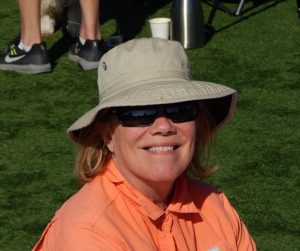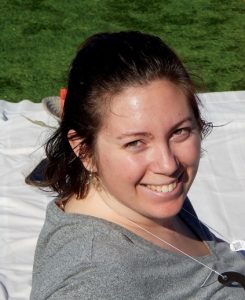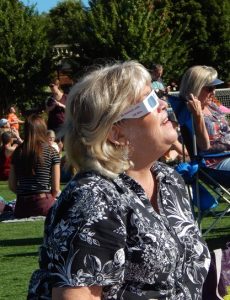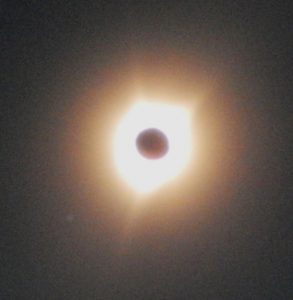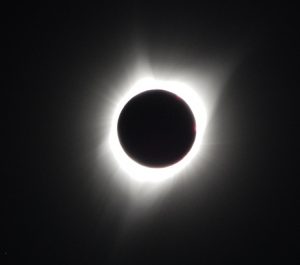What Our Guides Do On Vacation: Oregon’s Total Eclipse!
After weeks of discussion, we finally committed to shut down tours for 2 days, so we could travel to a friend’s house in Corvallis, Oregon within the path of totality. Guides Ira and Ken, plus Lisa, and our tour coordinator, Matty’s husband, Joe, and a friend, Catherine who Ira and Ken know from the UCLA Bruin Mountaineers were the personnel who left Mariposa on Saturday, August 19th. We planned to stay at another former Bruin Mountaineer, Nena’s, house where we also planned to meet Ken’s daughter, Briana, and a former river trip friend of Ken and Ira, Christine.
Due to the fires in California, the trip up into southern Oregon, on Saturday, was so smoky that we could barely see Mt. Shasta, but after Grants Pass, we hit some northerly winds, and the skies began to clear, giving us hope that we might actually be able to see the eclipse. By Sunday, the skies were quite clear, and after a very social breakfast, most of our group spent the day around the Oregon State University (OSU) campus scouting out potential viewing sites, attending an excellent eclipse-related lecture by a local professor, and creating eclipse-related artwork.
On Monday, eclipse day, we rose early and walked to the OSU soccer field where several hundred other people were settling in.
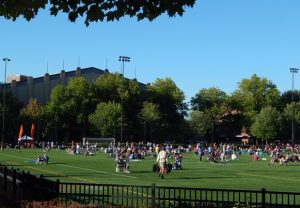
About every half hour a balloon was launched by the NASA Eclipse Balloon Project, carrying equipment up to 100,000 feet to live-stream imagery and other data from that perspective of the eclipse.
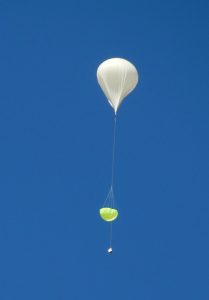
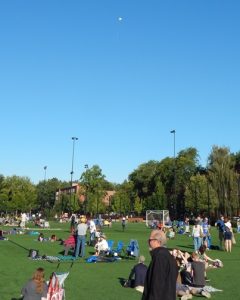
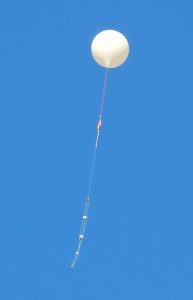
Meanwhile, every few minutes, private jets or air-taxis were bringing in folks who didn’t want to brave the highway traffic and could afford private air service to see the eclipse.
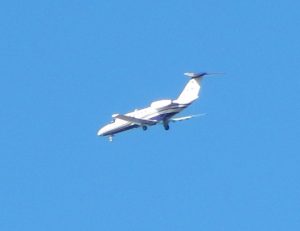
As the eclipse approached totality, 6 of us, left to right (Ken, Lisa, Briana, Nena, Christine, and Lauren (a friend of Nena’s) posed in our protective eclipse glasses.
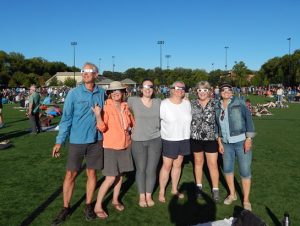
In the meantime, I took a few portraits of…
At the talk that we attended the previous day on campus, Randall Milstein encouraged his audience to focus on our own eclipse experience and to connect with our friends and neighbors and their parallel experiences. However, one of our “neighbors” shouted out to the rest of his “neighbors,” “Be quiet for the next 20 minutes; this is a sacred event. Pass this message on.” I thought, “If you didn’t want to connect with others, why did you choose to sit in the midst of a couple of hundred people and not go out into the desert of eastern Oregon?” It seemed that everyone ignored him though no one was loud or obnoxious, and everyone was respectful of the event.
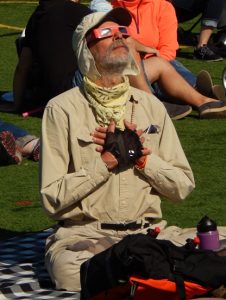
As the moon increasingly covered the sun, the sunlight continued to dim; the radiant warmth of the sun continued to decline; a breeze increased. At long last, so it seemed, totality arrived! We removed our protective glasses, and the spectacle that we had all awaited arrived! We, momentarily, could see Bailey’s Beads when the sun is still shining through the mountains and craters’ rims on the moon. Then the sun’s corona seemed to burst outward from the sun-moon and dominated the sky!
As our eyes adjusted to the new light conditions, we could see more and more of the sun’s corona and, with binoculars, we could also see reddish solar prominences, especially at about 1:30 and 3:00 o’clock along the rim of the sun.
The time of totality lasted about a minute and 40 seconds at our locality, but it seemed to pass SO QUICKILY and left us all yearning for MORE! Once the moon began to recede from the disc of the sun, all was a kind of anti-climax. People began leaving, and the anticipation that we’d all felt before totality was definitely gone. Our group sat for quite a while, reflecting on our personal and collective experiences, but we finally gathered up our stuff and walked back to Nena’s house for a relaxing afternoon.
The next morning, after packing up the van, taking a few photos, and dropping Briana off at the bus depot, we headed south. We noticed the thick smoke in Oregon and realized how lucky we were to have had ideal atmospheric conditions for the eclipse. As we drove southward, the smoke seemed to clear somewhat. By the time we reached Mt. Shasta, we could see the full outline of the mountain and some of its glaciers, much more than we’d seen on our trip northward.
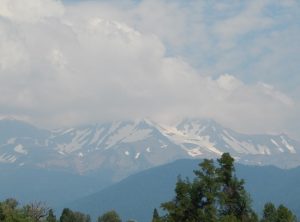
The only traffic slow-downs we experienced were related to road construction or the usual rush-hour traffic near Sacramento, not to the eclipse traffic which had been so highly publicized.

